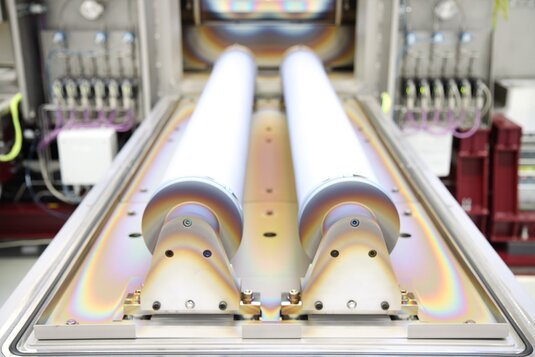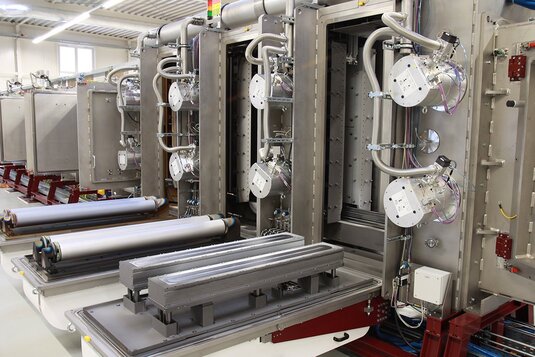Absorber Pipes for Solar Thermal Energy
Sputter coating system for selective absorber layers on heat transfer tubes
APPLICATION
Solar energy is free, and reaches us with outstanding reliability even in drier regions than Germany. Solar thermal energy does not require complex semiconductor components like photovoltaics, but rather directed light irradiation. With this technology, mirrored parabolic troughs focus the sunlight onto an absorber tube. The liquid flowing through the absorber tube is heated to up to 450 °C in the process. As in any thermal power plant, this heat can be used to generate electricity. The absorption of the absorber tube is decisive for the efficiency of solar thermal energy. For this reason, the pipe’s entire circumference is coated with a selective absorber layer – a stack of metal-ceramic layers – to achieve absorption coefficients of over 90 %.

REQUIREMENTS FOR THE SYSTEM
The system will be able to coat up to twelve stainless steel absorber pipes at the same time. The pipes are 4 m long and must be coated evenly around the entire circumference with an anti-reflective coating consisting of several individual layers. The system must possess the high level of productivity required for a production plant and relieve the operator of the task of moving heavy loads.
- The tube must withstand contact with hot thermal fluid
- High light absorption properties of the tube
- Tube evenly coated around the entire circumference

SOLVING THE REQUIREMENTS
FHR.Line.1200-V is a vertical inline system with an input lock, process area and output lock, as well as a carrier return system. The huge carriers (substrate holders) into which the tubes are inserted contain a device that allows all the tubes to rotate continuously and thus enables uniform coating from all sides. Pipe and planar targets are used in the actual process area. For easy changing of the 1200 mm targets, the flanges with the sputter sources are folded forward.

THE SPECIAL FEATURES OF THE FHR.Line.1200-V
- All-round coating thanks to rotation in a vacuum
- Substrates: Stainless steel tubes of various diameters
- Carrier transport including return completely developed and automated by FHR
- Highest material utilization and longest target service life through the use of tubular cathodes

Your Contact Person
Do you have any questions?
Would you like to know more about FHR.Line product range? Our expert, Sven Häberlein, will be happy to help you. Get in touch with us.


